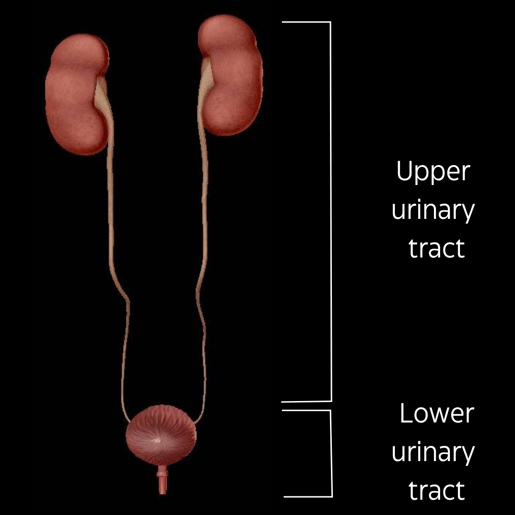TMI About the UTI: All About Urinary Tract Infections
Posted on 7/7/23 by Sarah Boudreau
Everybody pees—and urinary tract infections (UTIs) are very common. Let’s learn more about urinary tract anatomy, UTI causes, types of infections, and symptoms, then let’s unpack some common UTI advice.
Does cranberry juice actually help UTIs? Read on to find out!
The urinary tract
First off, what even is the urinary tract?
Let’s start small: the functional unit of the kidney is the nephron, which produces urine by removing waste and excess substances from the blood.
.png?width=515&height=386&name=My%20project-1%20(18).png)
Image of nephron microanatomy model in Visible Body Suite.
Nephrons make up most of the kidney’s cortex (the exterior of the kidney) and medulla (the interior). The medulla contains the renal pyramids, which do the bulk of urine production.
Urine produced by the nephrons flows from the renal pyramids into the renal pelvis. The renal pelvis is a system of tubes that connect and flow into the ureter.
.png?width=515&height=386&name=My%20project-1%20(17).png)
Image of kidney model in Visible Body Suite.
Each kidney has a ureter, a long tube that carries urine out of the kidney. Smooth muscle in the walls of the ureter push the urine into its next location: the bladder.
The bladder is like a balloon: its shape is dictated by how full it is. When the bladder contains around 200 milliliters of urine, the detrusor muscle contracts and the internal urethral muscle relaxes, creating that “gotta go” feeling.
Urine’s journey out of the bladder depends on if you have a male or female system. In the male system, the urethra is about 6-8 inches in length and extends from the bladder’s urethral orifice to the end of the penis, while in the female system, the urethra is about 1.5 inches long and passes through the urogenital diaphragm before terminating in front of the vaginal opening.
How does the urinary tract get infected?
UTIs are one of the most common infections in women; about 40% will experience a UTI in their lifetime. This is because the female urinary tract is susceptible to infection: bacteria from the rectum and perineum can more easily move into the urethra. Plus, since the urethra is so short, it’s easier to move into the bladder.
Some risk factors for UTIs include:
- Using a urinary catheter
- Sexual intercourse
- Using spermicides and diaphragms
- Having a kidney transplant
Types of UTI
There are actually two types of UTIs. A lower UTI is an infection in the bladder and surrounding structures. Lower UTI infections are common and are typically considered uncomplicated UTIs. On the other hand, an upper UTI is an infection in the kidneys. Upper UTIs tend to be more severe than lower UTIs.
In a lower UTI, bacteria (typically E. coli) trigger an inflammatory reaction in the bladder mucosal wall, called cystitis. Some symptoms of a lower UTI are:
- Frequent urination
- Pain when urinating
- Blood in urine

Kidney infections, aka upper UTIs or pyelonephritis, are also caused by bacteria working their way up the urinary tract, but lower UTIs and kidney infections are different in key ways.
Some symptoms of an upper UTI are:
- Fever
- Chills
- Back pain
- Vomiting and nausea
While lower UTIs tend to resolve on their own, an untreated kidney infection can lead to permanent kidney damage.
UTIs and the elderly
Did you know that UTIs account for about a quarter of all hospitalizations for geriatric patients?
All of those symptoms above describe how UTIs present in adults. For older adults, UTIs look quite different, with symptoms including:
- Tachycardia
- Incontinence
- Hypotension
- Drowsiness
- Frequent falls
- Delirium
Let’s take a closer look at that last symptom, delirium. Delirium has a quick onset, often within just hours or a few days, and is a shift in mental state. People with delirium experience confusion, trouble focusing, memory problems, and have difficulty processing information and expressing themselves. Delirium typically occurs in the elderly and is often brought on by stressors.
It’s not clear why delirium is connected to UTIs. There are three potential causes:
- The inflammation caused by UTIs causes the delirium
- Having delirium increases the risk of getting a UTI because people with delirium may not be able to maintain hygiene
- The body is dealing with another health condition, increasing likelihood of developing delirium and a UTI
It’s important to be aware of how UTIs present in the elderly because older adults have atypical symptoms—including delirium.
Fact or fiction?
In regards to UTIs, two very common pieces of “advice” are: pee after sex to prevent a UTI and drink cranberry juice to help get rid of one. Let’s take a closer look at each of those suggestions.
Urinate after intercourse
We talked earlier about how the female urinary tract is more susceptible to UTIs. As a way to prevent UTIs, many medical professionals suggest urination after intercourse to flush out bacteria that the movement may have moved into the urethra. After intercourse, the number of bacteria in the bladder can be ten times higher!
It’s common advice, but there is actually no proof to back up the assertion that urination after intercourse reduces the chance of getting a UTI. Despite the lack of evidence, it’s still suggested by professionals because it’s harmless—basically, it might not work, but it won’t hurt to try.
Drink cranberry juice
Ever wonder what gives cranberries their beautiful red color? It’s proanthocyanidins, the same chemical compound that people say helps prevent or recover from UTIs. A-type proanthocyanidins can stop bacteria from adhering to the walls of the bladder, and cranberries are richer in A-type proanthocyanidins than many other fruits.

Cranberries are high in A-type proanthocyanidins. Image by Irita Antonevica via Pexels.
Cranberry juice, pills, and other supplements are popular choices, but do they have an effect on UTIs? Probably not.
Research has shown very mixed results when it comes to cranberries and UTIs. Some research shows that cranberry helps stop UTI recurrence in general, some shows that cranberry helps stop UTI recurrence in certain populations, and some research shows that drinking cranberry juice had the same effect as a placebo.
When it comes to treatment, the best medicine is antibiotics, not cranberries!
Read More
Want to learn more about the urinary tract, surrounding structures, and pathologies? Check these out!
- The urinary system on the Visible Body Learn Site
- Painful Pebbles: The Anatomy and Pathology of Kidney Stones
- How Does Caffeine Affect the Body?
- The Biome Inside You: An Introduction to Gut Flora
Be sure to subscribe to the Visible Body Blog for more anatomy awesomeness!
Are you an instructor? We have award-winning 3D products and resources for your anatomy and physiology course! Learn more here.



